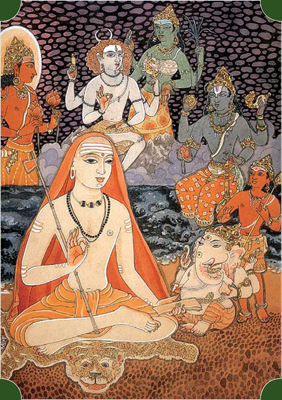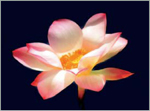
What Is the Universalistic Smarta Sect?
Smartism is an ancient brahminical tradition reformed by Shankara in the ninth century. Worshiping six forms of God, this liberal Hindu path is monistic, nonsectarian, meditative and philosophical. Aum.§
Adi Shankara lived from 788 to 820 ce, a mere 32 years, yet he gave Hinduism a new liberal denomination—Smartism. Here, wearing sacred marks, he holds his writings and is flanked by the six Deities of the Smarta altar: Surya the Sun, Siva, Shakti, Vishnu, Kumaran and Ganesha.§
 MARTA MEANS A FOLLOWER OF CLASSICAL SMRITI, particularly the Dharma Shastras, Puranas and Itihasas. Smartas revere the Vedas and honor the Agamas. Today this faith is synonymous with the teachings of Adi Shankara, the monk-philosopher known as Shanmata Sthapanacharya, “founder of the six-sect system.” He campaigned India-wide to consolidate the Hindu faiths of his time under the banner of Advaita Vedanta. To unify the worship, he popularized the ancient Smarta five-Deity altar—Ganapati, Surya, Vishnu, Siva and Shakti—and added Kumara. From these, devotees may choose their “preferred Deity,” or Ishta Devata. Each God is but a reflection of the one Saguna Brahman. Shankara organized hundreds of monasteries into a ten-order, dashanami system, which now has five pontifical centers. He wrote profuse commentaries on the Upanishads, Brahma Sutras and Bhagavad Gita. Shankara proclaimed, “It is the one Reality which appears to our ignorance as a manifold universe of names and forms and changes. Like the gold of which many ornaments are made, it remains in itself unchanged. Such is Brahman, and That art Thou.” Aum Namah Sivaya. §
MARTA MEANS A FOLLOWER OF CLASSICAL SMRITI, particularly the Dharma Shastras, Puranas and Itihasas. Smartas revere the Vedas and honor the Agamas. Today this faith is synonymous with the teachings of Adi Shankara, the monk-philosopher known as Shanmata Sthapanacharya, “founder of the six-sect system.” He campaigned India-wide to consolidate the Hindu faiths of his time under the banner of Advaita Vedanta. To unify the worship, he popularized the ancient Smarta five-Deity altar—Ganapati, Surya, Vishnu, Siva and Shakti—and added Kumara. From these, devotees may choose their “preferred Deity,” or Ishta Devata. Each God is but a reflection of the one Saguna Brahman. Shankara organized hundreds of monasteries into a ten-order, dashanami system, which now has five pontifical centers. He wrote profuse commentaries on the Upanishads, Brahma Sutras and Bhagavad Gita. Shankara proclaimed, “It is the one Reality which appears to our ignorance as a manifold universe of names and forms and changes. Like the gold of which many ornaments are made, it remains in itself unchanged. Such is Brahman, and That art Thou.” Aum Namah Sivaya. §

